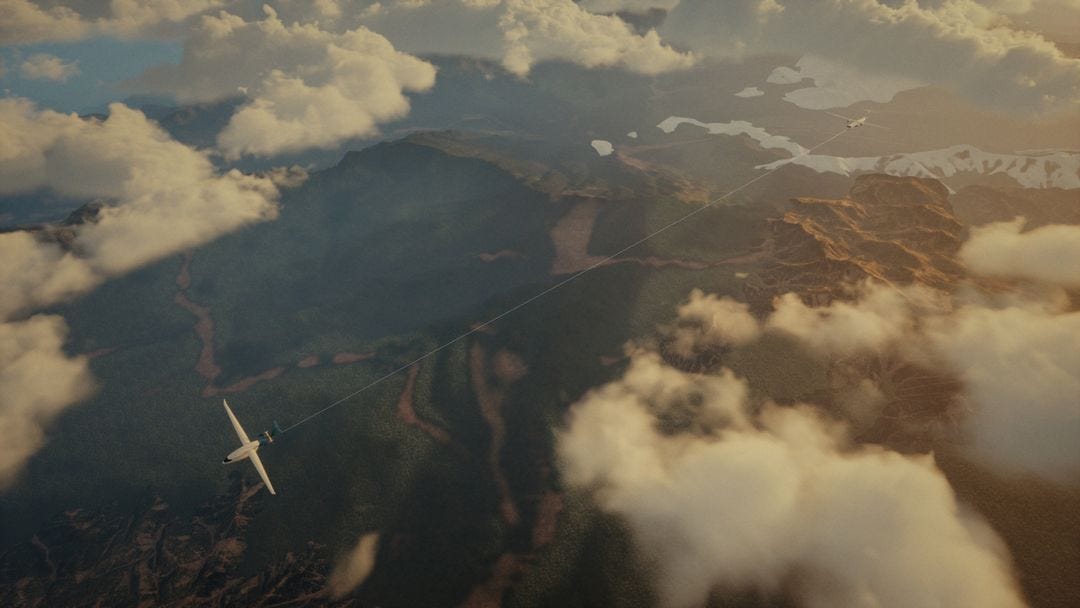Magpie aims to build an ‘electric tow network for the skies’
New startup presents radical vision of how long range electric flights could become a reality.
Imagine a zero emissions flight from San Francisco, California to Denver, Colorado in five years from now, in 2028. That’s a distance of 823 nautical miles or just over 1500 km.
Unfortunately, those 1500km will be beyond the range of the electric or hybrid-electric aircraft currently in development due to battery technology limitations.
For example, even if you reduce the number of seats on Heart Aerospace’s planned ES-30 aircraft from 30 to 25, the range is still only 800km.
Magpie Aviation has a solution to make that 1500km zero-emissions flight possible. We spoke to CEO Damon Vander Lind, who said that Magpie is creating “an electric tow network for the skies.”
Using the San Francisco to Denver example, your electric aircraft would first take off from San Francisco.
Then while it’s in the air, Damon told us that it would be met with an all-electric tow aircraft that hooks onto it and tows it part of the way. That plane has no passengers, just batteries to give it range.
“You get picked up, you connect on tow over the Central Valley of California, at maybe 8000 feet. You get towed up to 30-35,000 feet. You get towed to the Eastern plains of Nevada. When your tow plane is out of juice, it lands, another tow plane comes and picks you up and takes you the rest of the way.”
Magpie aims for its solution to be cost-effective – considerably cheaper than a SAF-powered journey for the same route – because the tow planes will take off and land from secondary airports. And, of course, unlike SAF, the journey will be true zero, completely emissions-free.
Then, using the example of a San Francisco to Denver flight, much of it passes over sparsely populated land, some of which could be utilised for solar power generation, to help power the recharging infrastructure needed for the tow aircraft.
Prove the technology and the market will follow
Aviation startup founders often tell us that much of the industry is quite conservative, being based on legacy systems and incremental improvements – one or two percent here and there. But that it’s not geared up in such a way to disrupt itself.
And so, even though the idea of aero-towing isn’t new, applying that to commercial aviation would still take quite a leap of imagination.
How does Magpie intend to convince airline bosses to buy into its fairly radical solution?
Damon told us that:
“If you have physics on your side, things tend to go your way in the long run. It just requires patience and sticking with the solution long enough to prove it. Every time we go out and every time we flight test and build experience, and get further down the road with the FAA, it changes from being a wild idea to inevitability.”
Damon also pointed out that the introduction of a new technology inevitably leads to a change in operations at a business level and in a change in behaviour by consumers.
Using the example of electric cars, they might have a range of 70 miles before needing a recharge. But consumers have adapted it as “most of your charging happens at home”, to the point where it becomes second nature.
Start with a single route and grow the market
Larger market adoption can also be achieved by proving the concept on a single route to start off with:
“A lot of times you can think of this grand vision of where aviation should go. But it’s not really a good starting point to say, well I need 100 tow aircraft and 100 payload aircraft just for it to work out.” Instead, “we can start with a single tow and a single payload aircraft, and we can just fly it back and forth.”
Examples Damon gave us were LA to San Francisco or London to Paris.
Using the London to Paris example, the actual commercial flight might go from London Gatwick or Heathrow to Paris CDG or Orly. But the tow aircraft could take off and land from (e.g.) Biggin Hill and Beauvais.
That would mean that the tow aircraft is always ready. So when the plane descends, lands and turns around at Paris CDG, the tow aircraft has already recharged and is in the air for the return trip.
A final advantage that Magpie offers is that the electric tow model can work with fossil-fuel-powered aircraft. Though it wouldn’t result in a net zero flight, it would still result in a significant carbon reduction.
First flight test milestone completed
Magpie has already passed its first flight test milestone. In March 2023, the company demonstrated the world’s first automated towing reconnections between two aircraft, saying that the connection took place “with centimetre-level precision.”
Magpie also benefits from a team with experience at both startup and legacy aviation companies.
For example, Damon Vander Lind and Co-Founder & CTO Andrew Goessling were both at Kitty Hawk, the now-closed urban air mobility company started by Google's Larry Page, whose technology lives on in eVTOL startup Wisk.
Head of Strategy and Partnerships Ollie Haas has had sustainability lead roles at Cathay Pacific and DBS Bank.
While Patrick Edmond, a veteran of the European Regional Airline industry, has joined as an advisor.
The company’s official launch announcement also generated significant interest in the aviation and technology trade press, including pieces in Engadget and Aviation Week.
When we asked Damon Vander Lind about a possible launch date, he said that rather than go public with some wildly ambitious date, he prefers to look at what’s feasible based on historical precedent.
He felt that certification could take two to three years, and being realistic, you might need to add a year on top of that. As a result, going live within the next five years seems to be within reach for Magpie.



